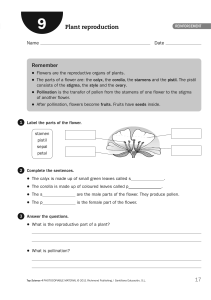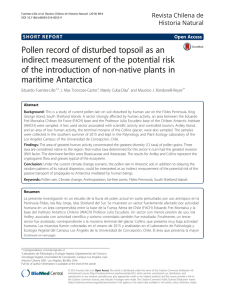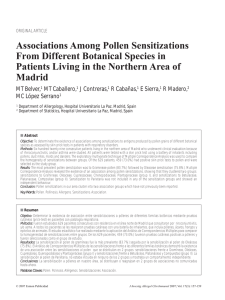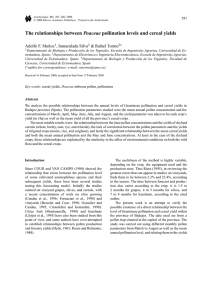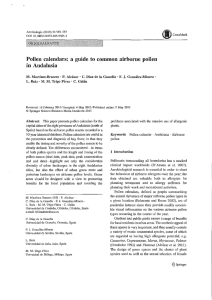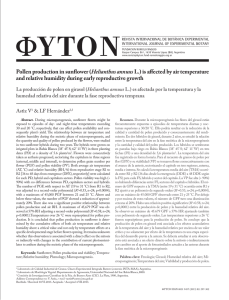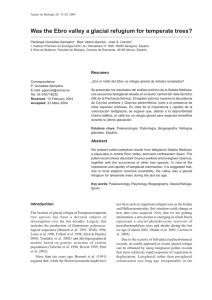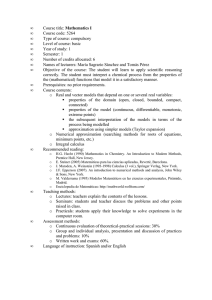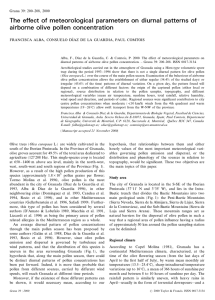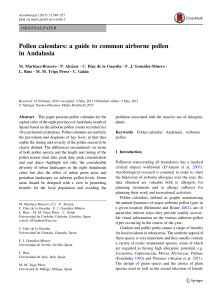Sphericity and smaller pollen-size are better represented
Anuncio
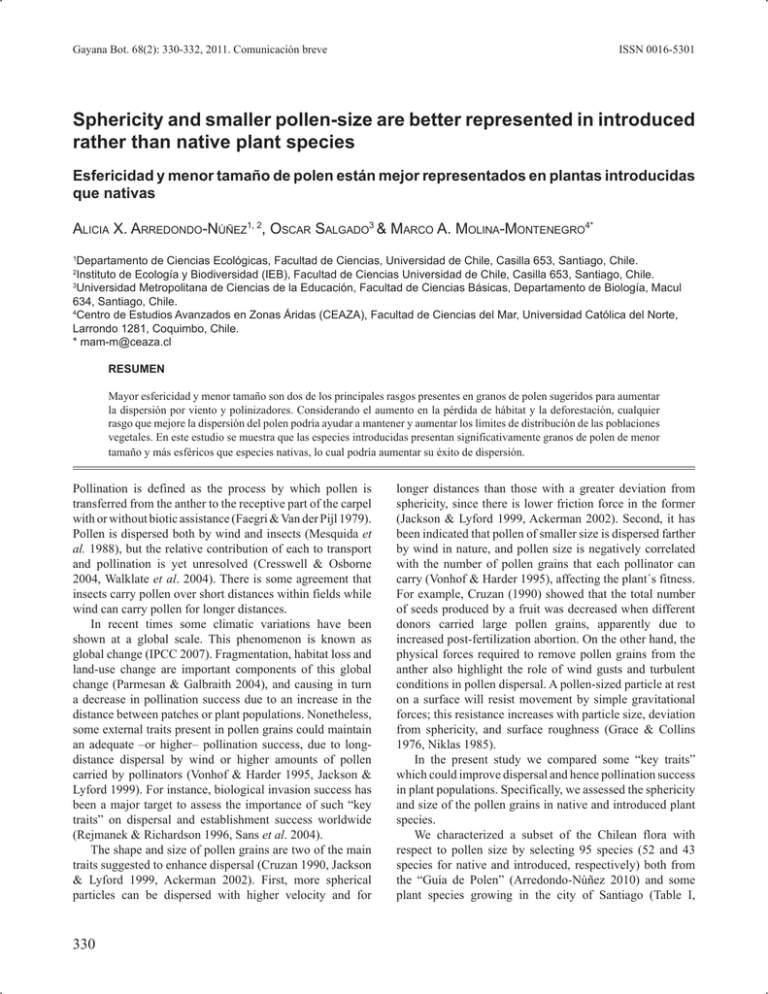
ISSN 0016-5301 Gayana Bot. 68(2): 330-332, 2011. Comunicación breve 68(2), 2011 Sphericity and smaller pollen-size are better represented in introduced rather than native plant species Esfericidad y menor tamaño de polen están mejor representados en plantas introducidas que nativas ALICIA X. ARREDONDO-NÚÑEZ1, 2, OSCAR SALGADO3 & MARCO A. MOLINA-MONTENEGRO4* Departamento de Ciencias Ecológicas, Facultad de Ciencias, Universidad de Chile, Casilla 653, Santiago, Chile. Instituto de Ecología y Biodiversidad (IEB), Facultad de Ciencias Universidad de Chile, Casilla 653, Santiago, Chile. 3 Universidad Metropolitana de Ciencias de la Educación, Facultad de Ciencias Básicas, Departamento de Biología, Macul 634, Santiago, Chile. 4 Centro de Estudios Avanzados en Zonas Áridas (CEAZA), Facultad de Ciencias del Mar, Universidad Católica del Norte, Larrondo 1281, Coquimbo, Chile. * [email protected] 1 2 RESUMEN Mayor esfericidad y menor tamaño son dos de los principales rasgos presentes en granos de polen sugeridos para aumentar la dispersión por viento y polinizadores. Considerando el aumento en la pérdida de hábitat y la deforestación, cualquier rasgo que mejore la dispersión del polen podría ayudar a mantener y aumentar los límites de distribución de las poblaciones vegetales. En este estudio se muestra que las especies introducidas presentan significativamente granos de polen de menor tamaño y más esféricos que especies nativas, lo cual podría aumentar su éxito de dispersión. Pollination is defined as the process by which pollen is transferred from the anther to the receptive part of the carpel with or without biotic assistance (Faegri & Van der Pijl 1979). Pollen is dispersed both by wind and insects (Mesquida et al. 1988), but the relative contribution of each to transport and pollination is yet unresolved (Cresswell & Osborne 2004, Walklate et al. 2004). There is some agreement that insects carry pollen over short distances within fields while wind can carry pollen for longer distances. In recent times some climatic variations have been shown at a global scale. This phenomenon is known as global change (IPCC 2007). Fragmentation, habitat loss and land-use change are important components of this global change (Parmesan & Galbraith 2004), and causing in turn a decrease in pollination success due to an increase in the distance between patches or plant populations. Nonetheless, some external traits present in pollen grains could maintain an adequate –or higher– pollination success, due to longdistance dispersal by wind or higher amounts of pollen carried by pollinators (Vonhof & Harder 1995, Jackson & Lyford 1999). For instance, biological invasion success has been a major target to assess the importance of such “key traits” on dispersal and establishment success worldwide (Rejmanek & Richardson 1996, Sans et al. 2004). The shape and size of pollen grains are two of the main traits suggested to enhance dispersal (Cruzan 1990, Jackson & Lyford 1999, Ackerman 2002). First, more spherical particles can be dispersed with higher velocity and for 330 longer distances than those with a greater deviation from sphericity, since there is lower friction force in the former (Jackson & Lyford 1999, Ackerman 2002). Second, it has been indicated that pollen of smaller size is dispersed farther by wind in nature, and pollen size is negatively correlated with the number of pollen grains that each pollinator can carry (Vonhof & Harder 1995), affecting the plant´s fitness. For example, Cruzan (1990) showed that the total number of seeds produced by a fruit was decreased when different donors carried large pollen grains, apparently due to increased post-fertilization abortion. On the other hand, the physical forces required to remove pollen grains from the anther also highlight the role of wind gusts and turbulent conditions in pollen dispersal. A pollen-sized particle at rest on a surface will resist movement by simple gravitational forces; this resistance increases with particle size, deviation from sphericity, and surface roughness (Grace & Collins 1976, Niklas 1985). In the present study we compared some “key traits” which could improve dispersal and hence pollination success in plant populations. Specifically, we assessed the sphericity and size of the pollen grains in native and introduced plant species. We characterized a subset of the Chilean flora with respect to pollen size by selecting 95 species (52 and 43 species for native and introduced, respectively) both from the “Guía de Polen” (Arredondo-Núñez 2010) and some plant species growing in the city of Santiago (Table I, Pollen traits in native and alien species: ARREDONDO-NÚÑEZ, A. ET AL. Supplementary Material). All species were separated into native and introduced categories for analysis. To test the hypothesis that active dispersal strategies aid in the success of introduced species, we compared by one-way ANOVA the maximum pollen-size and sphericity index for all species. The sphericity index was calculated according to the following equation (Jou et al. 1995): Where “a” is the major semi-axis and “b” is the minor semiaxis. Overall, introduced plant species showed significantly smaller pollen-size (F1, 93 = 3.96; p = 0.048) than native species (Fig. 1A). Similarly, those plant species corresponding to introduced status showed significantly (F1, 93 = 7.55; p = 0.007) more spherical pollen grains than natives (Fig. 1B). Ecologists have long been fascinated by the question of which species traits can predict their potential for dispersal and colonization of a new environment. Elton (1958) hypothesized that species able to establish themselves in new communities possessed abilities or traits that allowed them to use resources or tolerate stresses in ways that native species cannot. Following the same logic we can suggest that those plant species that are able to improve their pollen dispersal either by wind or pollinators could maintain their population size or spread their distributional ranges. Several physical and biotic features act, at least potentially, as “filters or barriers” to invasion (Kruger et al. 1986). The success of many invaders can also be ascribed, at least partly, to the beneficial effects of various abiotic features in the target systems. Many invasions, therefore, rely on inherent properties of the invaded system for their success. For example, wind is often a very important vector of dispersal for seeds or pollen grains of incipient invaders. On the other hand, mutualisms involving animal-mediated pollination and pollen dispersal often facilitate invasions (Richardson et al. 2000). The spread of many alien plants, particularly woody ones, depends on pollinator mutualisms (Simberloff 2006). Most alien plants are well served by generalist pollinators (insects and birds), and pollinator limitation does not appear to be a major barrier for the spread of introduced plants. Thus, pollen grains with smaller size and more sphericity could have a greater advantage, as could those from introduced plant species. Additionally, presence of exine ornamentation could be other trait that difficult the dispersal of pollen grains, and in our study we found this structure mainly in natives than introduced with 67% and 16%, respectively (Table I, Supplementary Material). Nevertheless, an increase in the distance between patches or between plant populations could result in reduced pollination success because pollination service would become less efficient, making wind dispersal more important. Currently, habitat loss and land-use change are arising as components of global change, resulting in more distanced plant populations (Parmesan & Galbraith 2004). Thus, plant species showing “key traits” in their pollen grains will maintain efficient dispersal and hence higher pollination success. Ecological studies have shown that in many cases terrestrial plants have responded to climate changes by migrating rather than evolving to adapt to them (Graham & Grimm 1990). Given the extreme climate changes predicted and increasing rates of habitat loss and fragmentation, longdistance dispersal will be essential to allow species to move across fragmented landscapes (Thomas et al. 2004). For species with obvious adaptations for long-distance dispersal (e.g., introduced species), “key traits” that improve the capacity for dispersal either by wind or pollinators might play a pivotal role in the future. Thus, a better understanding of dispersal in general, and pollen dispersal traits in particular, become essential to understanding the responses of plants to habitat loss and fragmentation under a future scenario of global change. FIGURE 1. Maximum size (A) and sphericity index (B) of pollen grains of native (filled bars) and introduced (empty bars) plan species. Are showed ± 2EE. Asterisks indicate significant differences. FIGURA 1. Tamaño máximo (A) e índice de esfericidad (B) de granos de polen pertenecientes a especies de plantas nativas (barras llenas) e introducidas (barras vacías). Se muestran ± 2EE. Asteriscos indican diferencias significativas. 331 Gayana Bot. 68(2), 2011 TABLE I. Family, origin, maximum size (μm), sphericity index and presence of exine ornamentation (x) of the species used in this study. TABLA I. Familia, origen, tamaño máximo (μm), índice de esfericidad y presencia de ornamentación de la exina (x) de las especies utilizadas en el presente estudio. SPECIES FAMILY ORIGIN Abutilon indicum Acanthus mollis Alstroemeria ligtu Alstroemeria revoluta Anagallis alternifolia Anagallis arvensis Antirrhinum majus Aristotelia chilensis Baccharis sagittalis Bellis perennis Bergenia crassiflora Bomarea salsilla Calceolaria integrifolia Calendula arvensis Centaurium cachanlahuen Chloraea chrysantha Chloraea longipetala Cirsium vulgare Citrus limonum Colletia hystrix Colliguaja dombeyana Convolvulus arvensis Crassula arborescens Cydonia oblonga Cynoglossum creticum Cytisus scoparius Datura stramonium Desfontainia fulgens Digitalis purpurea Dioscorea brachybothrya Drimys winteri Escallonia pulverulenta Escallonia revoluta Fabiana imbricata Francoa appendiculata Fuchsia magellanica Gamochaeta spicata Gamochaeta stachydifolia Gaultheria insana Geranium berteroanum Gevuina avellana Gochnatia foliolosa Hebertia lahue Hypericum caespitosum Iris spurea subsp. ochroleuca Lampranthus spectabilis Malvaceae Acanthaceae Alstroemeriaceae Alstroemeriaceae Primulaceae Primulaceae Plantaginacea Elaeocarpaceae Asteraceae Asteraceae Saxifragaceae Alstroemeriaceae Calceolariaceae Asteraceae Gentianaceae Orchidaceae Orchidaceae Asteraceae Rutaceae Rhamnaceae Euphorbiaceae Convolvulaceae Crassulaceae Rosaceae Boraginaceae Fabaceae Solanaceae Desfontainiaceae Plantaginaceae Dioscoreaceae Winteraceae Escalloniaceae Escalloniaceae Solanaceae Francoaceae Onagraceae Asteraceae Asteraceae Ericaceae Geraniaceae Proteaceae Asteraceae Iridaceae Hyperaceae Iridaceae Aizoaceae Introduced Introduced Native Native Native Introduced Introduced Native Native Introduced Introduced Native Native Introduced Native Native Native Introduced Introduced Native Native Introduced Introduced Introduced Introduced Introduced Introduced Native Introduced Native Native Native Native Native Native Native Native Native Native Native Native Native Native Native Introduced Introduced MAXIMUM SIZE SPHERICITY INDEX 90.26 74.65 101.40 123.86 38.08 49.52 38.24 26.53 108.36 40.55 64.13 92.20 35.27 38.24 52.33 126.23 129.34 84.66 40.50 43.27 103.51 56.88 25.98 60.67 32.63 50.06 120.17 120.31 50.52 52.94 59.04 32.74 32.57 48.27 39.29 78.61 23.71 51.33 69.82 52.73 73.98 130.85 92.64 330.53 75.89 56.56 0.37 0.15 0.14 0.13 0.27 0.22 0.40 0.46 0.16 0.44 0.49 0.14 0.32 0.56 0.42 0.17 0.15 0.26 0.43 0.28 0.24 0.29 0.40 0.94 0.19 0.37 0.87 0.24 0.29 0.17 0.21 0.69 0.21 0.19 0.18 0.16 0.44 0.29 0.30 0.87 0.31 0.30 0.16 0.20 0.19 0.34 ORNAMENTATION x x x x x x x x x x x x x x x x x x x x x Pollen traits in native and alien species: ARREDONDO-NÚÑEZ, A. ET AL. SPECIES FAMILY ORIGIN Lapageria rosea Leontodon taraxacoides Lepechinia chamaedryoides Libertia sessiliflora Ligustrum vulgare Lilium sp. Lithrea caustica Lobelia tupa Lotus corniculatus Lythrum hyssopifolia Malva sylvestris Mentha pulegium Muehlenbeckia hastulata Mutisia ilicifolia Myrceugenia pinifolia Narcissus tazetta Nicotiana acuminata Osteospermum fruticosum Oxalis articulata Oxalis pes-caprae Papaver setigerum Pelargonium peltatum Platanus orientalis Podanthus ovatifolius Prunus domestica Punica granatum Puya berteroniana Quinchamalium chilense Rosa canina Rosa rubiginosa Rosa sp. Rubus ulmifolius Rumex acetosella Senecio vulgaris Senna stipulacea Silybum marianum Sophora macrocarpa Stachys grandidentata Taraxacum officinale Teline monspessulana Teucrium bicolor Trifolium repens Tristerix corymbosus Tulipa sp. Ugni molinae Uncinia phleoides Valeriana aff. stricta Viola portalesia Zantedeschia aethiopica Philesiaceae Asteraceae Lamiaceae Iridaceae Oleaceae Liliaceae Anacardiaceae Campanulaceae Fabaceae Lythraceae Malvaceae Lamiaceae Polygonaceae Asteraceae Myrtaceae Amaryllidaceae Solanaceae Asteraceae Oxalidaceae Oxalidaceae Papaveraceae Geraniaceae Platanaceae Asteraceae Rosaceae Lythraceae Bromeliaceae Santalaceae Rosaceae Rosaceae Rosaceae Rosaceae Polygonaceae Asteraceae Fabaceae Asteraceae Fabaceae Lamiaceae Asteraceae Fabaceae Lamiaceae Fabaceae Loranthaceae Liliaceae Myrtaceae Cyperaceae Valerianaceae Violaceae Araceae Native Introduced Native Native Introduced Introduced Native Native Introduced Introduced Introduced Introduced Native Native Native Introduced Native Introduced Native Introduced Introduced Introduced Introduced Native Introduced Introduced Native Native Introduced Introduced Introduced Introduced Native Introduced Native Introduced Native Native Introduced Introduced Native Introduced Native Introduced Native Native Native Native Introduced MAXIMUM SIZE SPHERICITY INDEX ORNAMENTATION 102.56 56.78 86.05 52.95 48.29 156.52 54.96 55.48 22.00 57.37 71.97 72.51 29.66 134.18 54.67 25.98 65.85 52.17 53.79 54.78 29.34 76.53 33.98 38.50 60.27 52.63 64.04 40.75 102.13 48.45 60.91 62.52 87.36 82.37 52.33 85.14 39.61 55.00 52.18 47.38 108.03 52.05 53.05 95.14 24.78 108.06 59.89 63.54 87.02 0.15 0.18 0.19 0.17 0.40 0.12 0.30 0.29 0.95 0.46 0.31 0.34 0.45 0.14 0.12 0.16 0.29 0.39 0.36 0.44 0.25 0.31 0.28 0.25 0.27 0.32 0.21 0.20 0.56 0.78 0.28 0.29 0.23 0.26 0.21 0.31 0.28 0.53 0.39 0.37 0.16 0.98 0.23 0.20 0.73 0.52 0.57 0.30 0.15 x x x x x x x x x x x x x x x x x x x x x Gayana Bot. 68(2), 2011 ACKNOWLEDGMENTS We thank to J. Moroney for their useful comments about of the final version of this manuscript. This research was supported by Proyecto Anillo ACT34/2006. REFERENCES ACKERMAN, J.D. 2002. Diffusivity in a marine macrophyte canopy: implications for submarine pollination and dispersal. American Journal of Botany 89: 1119-1127. ARREDONDO-NÚÑEZ, A. 2010. Guía de Polen Reserva Nacional Los Ruiles. Alvimpress, Santiago. 69 pp. CRESSWELL, J.E. & J.L. OSBORNE. 2004. The effect of patch size and separateness on bumblebee foraging in oilseed rape (Brassica napus): implications for gene flow. Journal of Applied Ecology 41: 539-546. CRUZAN, M.B. 1990. Variation in pollen size, fertilization ability, and postfertilization siring ability in Erythronium grandiflorum. Evolution 44: 843-856. ELTON, C. 1958. The ecology of invasions by animals and plants. Methuen & Co. Ltd., London. 181 pp. FAEGRI, K. & L. VAN DER PIJL. 1979. The principles of pollination ecology. Pergamon Press, New York. 224 pp. GRACE, J. & M. A. COLLINS. 1976. Spore liberation from leaves by wind. In: C.H. Dickinsonb & T.F. Preece (eds), pp. 185-198. Microbiology of aerial plant surfaces. Academic Press, London. GRAHAM, R.W. & E.C. GRIMM. 1990. Effects of global climate change on the patterns of terrestrial biological communities. Trends in Ecology & Evolution 5: 289-292. IPCC. 2007. Intergovernmental panel on climate change. http:// www.ipcc.ch JACKSON, S.T. & M.E. LYFORD. 1999. Pollen dispersal models in quaternary plant ecology: assumptions, parameters, and prescriptions. Botanical Review 65: 39-75. JOU, D., J.E. LLEBOT & C. PÉREZ-GARCÍA. 1995. Física para ciencias de la vida. Editorial Reverté, Barcelona. 526 pp. KRUGER, F.J., D.M. RICHARDSON & B.W. VAN WILGEN. 1986. Processes of invasion by alien plants. In: I.A.W. Macdonald, F.J. Kruger & A.A. Ferrar (eds), pp. 145-155. The ecology and management of biological invasions in southern Africa. Oxford University Press, Cape Town. MESQUIDA, J., M. RENARD & J.S. PIERRE. 1988. Rapeseed (Brassica napus L.) productivity: the effect of honeybees (Apis mellifera L.) and different pollination conditions in cage and field tests. Apidologie 19: 51-72. NIKLAS, K.J. 1985. The aerodynamics of wind pollination. Botanical Review 51: 328-386. PARMESAN, C. & H. GALBRAITH. 2004. Observed impacts of global climate change in the U.S. Pew Center on Global Climate Change, Arlington. 55 pp. REJMÁNEK, M. & D.M. RICHARDSON. 1996. What attributes make some plant species more invasive? Ecology 77: 1655-1661. RICHARDSON, D.M., N. ALLSOPP, C.M. D´ANTONIO, S.J. MILTON & M. RAJMÁNEK. 2000. The plant invasions – the role of mutualisms. Biological Review 75: 65-93. SANS, F.X., H. GARCÍA-SERRANO & I. AFÁN. 2004. Life-history traits of alien and native Senecio species in the Mediterranean region. Acta Oecologica 26: 167-178. SIMBERLOFF, D. 2006. Invasional meltdown 6 years later: important phenomenon, unfortunate metaphor, or both? Ecology Letters 9: 912-919. THOMAS, C.D., A. CAMERON, R.E. GREEN, M. BAKKENES, L.J. BEAUMONT, Y.C. COLLINGHAM, B.F.N. ERASMUS, M. FERREIRA DE SIQUEIRA, A. GRAINGER, L. HANNAH, L. HUGHES, B. HUNTLEY, A.S. VAN JAARSVELD, G.F. MIDGLEY, L. MILES, M.A. ORTEGA-HUERTA, A. TOWNSEND PETERSON, O.L. PHILLIPS & S.E. WILLIAMS. 2004. Extinction risk from climate change. Nature 427: 145-148. VONHOF, M.J. & L.D. HARDER. 1995. Size-number trade-offs and pollen production by papilionaceous legumes. American Journal of Botany 82: 230-238. WALKLATE, P.J., J.C.R. HUNT, H.L. HIGSON & J.B. SWEET. 2004. A model of pollen-mediated gene flow for oilseed rape. Proceedings of the Royal Society of London B, 271: 441449. Recibido: 26.01.11 Aceptado: 18.04.11 332

